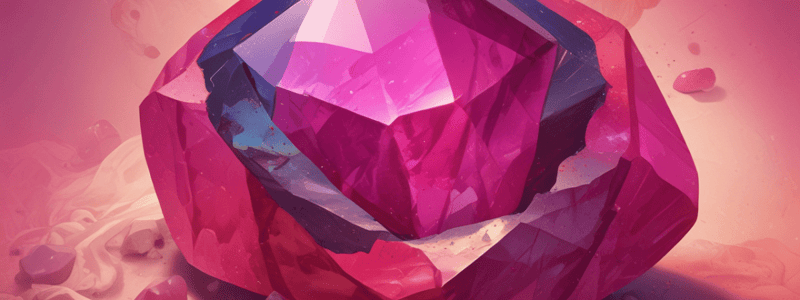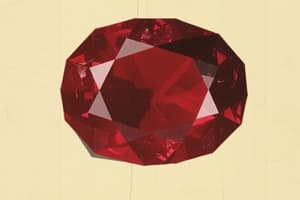Podcast
Questions and Answers
What is the Mohs scale hardness of rubies?
What is the Mohs scale hardness of rubies?
- 11
- 9 (correct)
- 8
- 10
Which of the following is NOT a major consumer of rubies?
Which of the following is NOT a major consumer of rubies?
- Brazil (correct)
- United States
- Japan
- China
What is the chemical composition of rubies?
What is the chemical composition of rubies?
- A mixture of silicon and oxygen
- A mixture of aluminum and silicon
- A mixture of iron and oxygen
- A mixture of aluminum and oxygen (correct)
What is the typical crystal structure of rubies?
What is the typical crystal structure of rubies?
What is the process that removes silicon from the rock, leading to the formation of rubies?
What is the process that removes silicon from the rock, leading to the formation of rubies?
What is the name of the species that rubies belong to?
What is the name of the species that rubies belong to?
What is the typical color range of rubies?
What is the typical color range of rubies?
Where are the finest rubies often found?
Where are the finest rubies often found?
What element is responsible for the saturated color of rubies?
What element is responsible for the saturated color of rubies?
What is a common clarity characteristic of rubies?
What is a common clarity characteristic of rubies?
What is the most common treatment for rubies?
What is the most common treatment for rubies?
What is the origin of 'Burmese' rubies?
What is the origin of 'Burmese' rubies?
What is the term for rubies with a rich, slightly purplish red color?
What is the term for rubies with a rich, slightly purplish red color?
What is the common synthetic process used to create rubies?
What is the common synthetic process used to create rubies?
What is a common imitation material for rubies?
What is a common imitation material for rubies?
What is the major cutting, treatment, and wholesale trading center for rubies?
What is the major cutting, treatment, and wholesale trading center for rubies?
What is a rare phenomenon observed in rubies?
What is a rare phenomenon observed in rubies?
What is the term for rubies with a brownish red to purplish red hue?
What is the term for rubies with a brownish red to purplish red hue?
What is the common cut for rubies?
What is the common cut for rubies?
What is the primary environment necessary for the formation of rubies?
What is the primary environment necessary for the formation of rubies?
What is the process that enables the exchange of chemical components between minerals?
What is the process that enables the exchange of chemical components between minerals?
What is the primary host rock where finest rubies are often found?
What is the primary host rock where finest rubies are often found?
What is the purpose of chromium in the formation of rubies?
What is the purpose of chromium in the formation of rubies?
What is the typical shape of ruby crystals?
What is the typical shape of ruby crystals?
What is the name of the process that removes silicon from the rock, leading to the formation of rubies?
What is the name of the process that removes silicon from the rock, leading to the formation of rubies?
Which of the following has a major impact on the tone of rubies?
Which of the following has a major impact on the tone of rubies?
Which of the following is NOT a significant consumer of rubies?
Which of the following is NOT a significant consumer of rubies?
What is the typical color range of high-end rubies?
What is the typical color range of high-end rubies?
What is the purpose of heat treatment on rubies?
What is the purpose of heat treatment on rubies?
What is the term for rubies with a rich, slightly purplish red color?
What is the term for rubies with a rich, slightly purplish red color?
What is the common synthetic process used to create rubies?
What is the common synthetic process used to create rubies?
What is the primary country of origin for the finest rubies?
What is the primary country of origin for the finest rubies?
What is the term for the clarity characteristic of rubies with needle-like inclusions?
What is the term for the clarity characteristic of rubies with needle-like inclusions?
What is the common cut used for rubies ?
What is the common cut used for rubies ?
What is the purpose of flux healing and lattice diffusion?
What is the purpose of flux healing and lattice diffusion?
What is the common imitation material for rubies?
What is the common imitation material for rubies?
What is the term for the phenomenon observed in rubies with pleochroism?
What is the term for the phenomenon observed in rubies with pleochroism?
What is the major cutting, treatment, and wholesale trading center for rubies?
What is the major cutting, treatment, and wholesale trading center for rubies?
Flashcards are hidden until you start studying
Study Notes
Ruby Overview
- Largest consumers of ruby include the US, China, Japan, the European Union, and the Middle East
- Ruby has a Mohs scale hardness of 9
Species and Composition
- Ruby is a species of Corundum
- Chemical composition: aluminum oxide, a mixture of aluminum and oxygen
- Forms in environments with low silicon content, part of the metamorphic process
Color and Hue
- Color range: orangy red to purplish red
- Finest ruby has a pure, vibrant red to slightly purplish red hue
- Vivid saturation and medium to medium dark tone
Forming Source and Process
- Finest rubies have trace elements of Chromium, which enhances hue and causes fluorescence
- Finest ruby forms in marble, but also found in alkali-basalt host rocks with trace elements of iron
- Metasomatism process involves minerals exchanging chemical components in the presence of fluids
- Desilication process removes silicon from the rock, leaving aluminum and oxygen behind to form corundum
Crystal Structure and Phenomena
- Crystal structure: tabular hexagonal prism, elongated prisms and bipyramids
- Possible phenomenon: Pleochroism
Clarity Characteristics
- Silk (rutile needles), boehmite needles, included crystals, fingerprint inclusions
- Growth zoning, color zoning, and color banding
Treatments and Cuts
- Almost all rubies are heat treated to develop or intensify color, remove or decrease banding or zoning
- Common treatments: fracture filling with lead glass, dyeing with colored oils, and filling small surface-reaching fractures with epoxies
- Common cuts: oval, cushion, round, trillion, emerald-cut, pear, and marquise
- Cutters can minimize orangy red color by orienting the table facet perpendicular to the crystal's optic axis
Trade Names and Countries of Origin
- Trade names: "pigeon's blood", "Burmese", "Thai", "Pailin", "crimson", and "scarlet"
- Countries of origin: Mozambique, Myanmar, Afghanistan, Vietnam, Thailand, Cambodia, India, Kenya, Sri Lanka, Tanzania, and Madagascar
Synthetics and Imitations
- Main synthetic process: Verneuil or flame-fusion method, melt and solution processes
- Common imitation materials: glass, natural spinel, red garnet, synthetic spinel, synthetic cubic zirconia, and quartz
Cutting and Trading Centers
- Thailand is considered ruby's major cutting, treatment, and wholesale trading center
- Other important ruby centers: Jaipur, India; Sri Lanka; and China's Guangdong Province
Ruby Overview
- Largest consumers of ruby include the US, China, Japan, the European Union, and the Middle East
- Ruby has a Mohs scale hardness of 9
Species and Composition
- Ruby is a species of Corundum
- Chemical composition: aluminum oxide, a mixture of aluminum and oxygen
- Forms in environments with low silicon content, part of the metamorphic process
Color and Hue
- Color range: orangy red to purplish red
- Finest ruby has a pure, vibrant red to slightly purplish red hue
- Vivid saturation and medium to medium dark tone
Forming Source and Process
- Finest rubies have trace elements of Chromium, which enhances hue and causes fluorescence
- Finest ruby forms in marble, but also found in alkali-basalt host rocks with trace elements of iron
- Metasomatism process involves minerals exchanging chemical components in the presence of fluids
- Desilication process removes silicon from the rock, leaving aluminum and oxygen behind to form corundum
Crystal Structure and Phenomena
- Crystal structure: tabular hexagonal prism, elongated prisms and bipyramids
- Possible phenomenon: Pleochroism
Clarity Characteristics
- Silk (rutile needles), boehmite needles, included crystals, fingerprint inclusions
- Growth zoning, color zoning, and color banding
Treatments and Cuts
- Almost all rubies are heat treated to develop or intensify color, remove or decrease banding or zoning
- Common treatments: fracture filling with lead glass, dyeing with colored oils, and filling small surface-reaching fractures with epoxies
- Common cuts: oval, cushion, round, trillion, emerald-cut, pear, and marquise
- Cutters can minimize orangy red color by orienting the table facet perpendicular to the crystal's optic axis
Trade Names and Countries of Origin
- Trade names: "pigeon's blood", "Burmese", "Thai", "Pailin", "crimson", and "scarlet"
- Countries of origin: Mozambique, Myanmar, Afghanistan, Vietnam, Thailand, Cambodia, India, Kenya, Sri Lanka, Tanzania, and Madagascar
Synthetics and Imitations
- Main synthetic process: Verneuil or flame-fusion method, melt and solution processes
- Common imitation materials: glass, natural spinel, red garnet, synthetic spinel, synthetic cubic zirconia, and quartz
Cutting and Trading Centers
- Thailand is considered ruby's major cutting, treatment, and wholesale trading center
- Other important ruby centers: Jaipur, India; Sri Lanka; and China's Guangdong Province
Studying That Suits You
Use AI to generate personalized quizzes and flashcards to suit your learning preferences.




